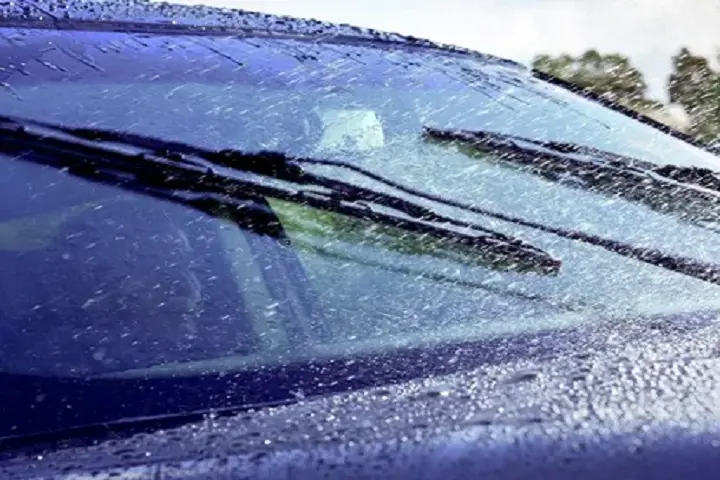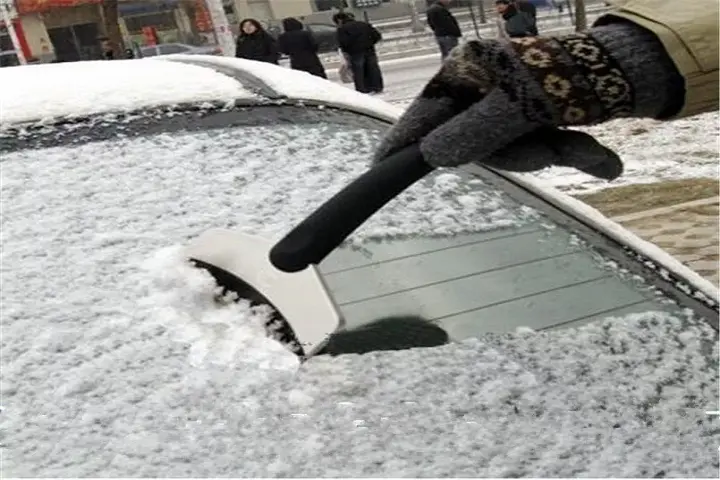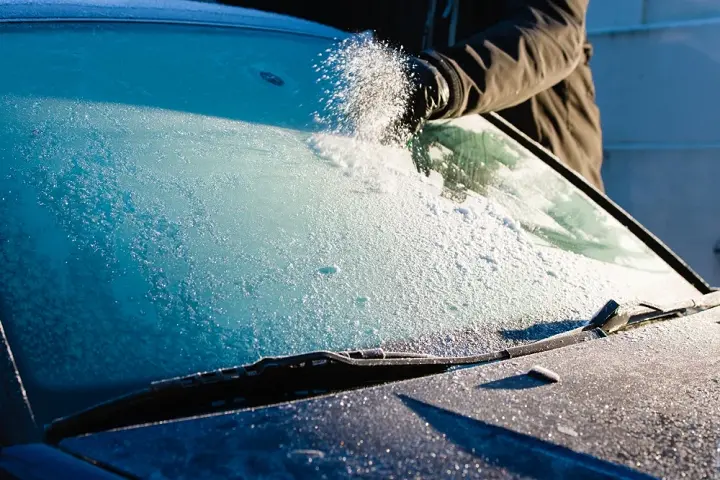Picture this: It’s a frosty morning, you’re running late, and your car’s windscreen is covered in a thick layer of ice. The temptation to grab a kettle of warm water is strong.
But is it ever okay to use warm water to defrost a windscreen? Let’s dive into this chilling topic and separate fact from fiction in our quest to safely navigate winter’s icy grip on our vehicles.
The Chilling Truth: Why Your Windscreen Freezes
Before we tackle the warm water question, let’s understand why your windscreen turns into an ice rink overnight. This knowledge is crucial for every driver facing the winter chill.
Science behind ice formation on glass
When the temperature drops below freezing, any moisture on your windscreen turns to ice. This process, known as nucleation, occurs when water molecules slow down and bond together, forming a crystalline structure. On a molecular level, it’s fascinating. For drivers, it’s a pain in the neck.
The smooth surface of glass provides an ideal platform for ice formation. Unlike rough surfaces where water can pool in tiny crevices, glass allows water molecules to spread evenly, creating a uniform layer of ice. This is why your windscreen often looks like it’s been painted with a brush of frost.
How weather conditions affect windscreen icing
It’s not just about temperature. Humidity plays a huge role too. Here’s a quick breakdown:
- High humidity + Low temperature = More ice: More moisture in the air means more potential for ice formation. When humid air comes into contact with your cold windscreen, it condenses and freezes rapidly.
- Clear skies = Faster cooling: Without cloud cover, heat escapes more quickly, leading to rapid temperature drops and ice formation. This is why frosty nights often coincide with clear, starry skies.
- Wind chill factor: Strong winds can accelerate the freezing process by removing any warm air near the surface of your car.
Fun fact: Did you know that frost can form even when air temperatures are above freezing? It’s all about the dew point and surface temperature of your car. If your car’s surface temperature falls below the dew point, frost can form even if the air temperature is slightly above 0°C (32°F).
Understanding these factors can help you predict when you’re most likely to face a frozen windscreen and prepare accordingly.
Warm Water on Ice: A Recipe for Disaster?

Now, let’s address the elephant in the room: using warm water to de-ice your windscreen. This seemingly quick fix can lead to serious consequences.
The thermal shock phenomenon explained
When you pour warm water on a frozen windscreen, you’re subjecting the glass to rapid temperature change. This is called thermal shock and it’s as risky as it sounds.
Glass expands when heated and contracts when cooled. When you introduce a sudden temperature change, different parts of the glass expand or contract at different rates. This can lead to stress fractures or, in worst-case scenarios, complete shattering.
To understand this better, imagine a rubber band. If you stretch it slowly, it adapts. But if you yank it suddenly, it’s likely to snap. Glass reacts similarly to sudden temperature changes.
Potential risks to your windscreen’s integrity
Using warm water doesn’t just risk immediate damage. It can weaken your windscreen over time, making it more susceptible to future cracks and chips. Here’s what you’re risking:
- Micro-cracks: Invisible to the naked eye but compromising the strength of your windscreen. These tiny fissures can grow over time, especially when subjected to road vibrations and temperature fluctuations.
- Existing damage worsening: Any small chips or cracks can expand dramatically. Water can seep into these imperfections, freeze, and expand, causing further damage.
- Complete shattering: In extreme cases, your entire windscreen could give way. This is not only costly but extremely dangerous if it happens while driving.
Real-life horror stories from drivers who learned the hard way
“I thought I was being clever using warm water from the kettle. Next thing I knew, my windscreen looked like a spider’s web of cracks. Lesson learned the hard way!” – John, 34, Manchester
John’s story isn’t unique. Many drivers have faced costly repairs or replacements after attempting this quick fix.
“I was already late for work and thought a bit of warm water would speed things up. The crack that formed ran right across my field of vision. I had to call in sick and deal with a hefty repair bill.” – Sarah, 28, Edinburgh
These stories serve as cautionary tales for anyone tempted to use warm water as a quick de-icing solution.
| Repair Type | Average Cost (UK) | Time to Repair |
| Chip Repair | £35 – £50 | 30 minutes |
| Crack Repair | £50 – £150 | 1-2 hours |
| Full Replacement | £150 – £300+ | 2-3 hours |
As you can see, what seems like a time-saving measure can actually cost you significantly in both time and money: Defrost a Windscreen
Safe Alternatives: Thawing Your Windscreen Without Breaking the Bank

Fear not! There are safer ways to tackle a frozen windscreen that won’t leave you out in the cold or with a damaged car: Defrost a Windscreen
The humble ice scraper: Old but gold
Sometimes, the simplest solutions are the best. A good quality ice scraper is an essential winter tool for any driver. Here’s how to use it effectively:
- Start your car and turn on the defrosters. This will help loosen the ice from the inside.
- Use a plastic scraper (never metal!) to remove ice in a horizontal motion. Plastic is less likely to scratch your windscreen.
- Work from the edges inward for best results. This technique helps prevent re-freezing of cleared areas.
- Be patient and apply steady, even pressure. Rushing can lead to scratches or personal injury.
Pro tip: Spray a mixture of water and vinegar on your windscreen the night before to prevent ice formation. The acidity of the vinegar lowers the freezing point of water, making it harder for ice to form.
De-icer sprays: Store-bought vs. DIY solutions
De-icer sprays are a quick and effective way to clear your windscreen. They work by lowering the freezing point of water, turning ice back into liquid even at sub-zero temperatures:
Store-bought de-icers are convenient but can be pricey. Look for environmentally friendly options that won’t harm your car’s paintwork. Many contain propylene glycol or ethylene glycol, which are effective but should be used carefully to avoid damage to your car’s finish.
DIY de-icer formula:
- 2 parts rubbing alcohol
- 1 part water
- A few drops of dish soap
Mix in a spray bottle and voilà! A homemade de-icer that’s gentle on your wallet and your car. The alcohol lowers the freezing point of water, while the soap helps break down the ice structure.
Remote start systems: Luxury or necessity?
For those who hate the morning de-icing ritual, a remote start system might be worth considering. These allow you to start your car and activate the defrosters from the comfort of your home.
Pros:
- Convenience: Start defrosting before you even leave the house
- Reduced exposure to cold: Less time spent shivering outside
- Car is warm when you get in: Improved comfort on cold mornings
Cons:
- Installation cost: Can be pricey, especially for newer, more complex vehicles
- Increased fuel consumption: Car runs while unattended
- Potential security risks: If not properly secured, could be exploited by thieves
While not essential, for those in particularly cold climates, a remote start system can be a game-changer in winter months.
Prevention: The Best Cure for a Frozen Windscreen

As with many things in life, prevention is better than cure when it comes to icy Defrost a Windscreen. Taking proactive steps can save you time and hassle on frosty mornings.
Weatherproofing your car: Tips and tricks
- Apply a protective wax layer: This creates a barrier between your windscreen and the elements. A good quality car wax can help water bead and run off rather than sticking and freezing.
- Use a water repellent spray: Products like Rain-X can help prevent ice adhesion. These sprays create a hydrophobic layer that causes water to bead up and roll off.
- Check your wipers: Worn wipers can leave streaks that freeze more easily. Replace them regularly, ideally before winter sets in.
- Maintain your washer fluid: Use a winter-grade washer fluid with anti-freeze properties. This can help prevent your washer system from freezing and provide some de-icing capability.
Parking strategies to minimize ice buildup
Where you park can make a big difference:
- Use a garage if possible: The most effective way to prevent ice is to keep your car out of the elements entirely.
- Park facing east to catch the morning sun: This natural de-icer can give you a head start on frosty mornings.
- Avoid parking under trees where water can drip and freeze: Trees can protect from some elements but can also be a source of dripping water that freezes on your car.
- Use covered parking when available: Even if you don’t have a garage, carports or covered parking can reduce ice formation.
The night-before prep that’ll save you morning headaches
A little evening effort goes a long way:
- Cover your windscreen with a specialized frost cover or even cardboard: This physical barrier prevents ice from forming directly on your glass.
- Lift your wipers off the glass to prevent freezing: This prevents them from freezing to the windscreen and potentially damaging the rubber.
- Check the weather forecast and plan accordingly: If you know a frost is coming, you can take extra precautions.
- Pre-treat your windscreen with a vinegar solution: As mentioned earlier, this can help prevent ice formation.
By implementing these preventive measures, you can significantly reduce the time and effort needed to clear your windscreen on cold mornings.
When Warm Water Might Be OK (Spoiler: It’s Complicated)
Despite the risks, there are scenarios where lukewarm water might be used – but proceed with extreme caution. It’s important to stress that this is still not recommended by most experts.
The lukewarm loophole: Temperature matters
If you must use water, ensure it’s lukewarm, not hot. The closer the water temperature is to the outside temperature, the less risk of thermal shock.
Temperature guide:
- Outside temp: 0°C (32°F)
- Safe water temp: 5-10°C (41-50°F)
Remember, even this small temperature difference can be risky. The safest option is always to avoid using water altogether.
Application techniques to minimize risk
If you decide to use lukewarm water:
- Start from the top of the windscreen: This allows the water to run down, gradually warming the glass.
- Use a slow, steady stream: Avoid dumping large amounts of water at once.
- Never pour directly onto cracks or chips: These weak points are more susceptible to damage.
- Follow immediately with an ice scraper: Remove any water quickly to prevent re-freezing.
Why experts still advise against it: Defrost a Windscreen
Despite these precautions, automotive experts and glass specialists universally advise against using water of any temperature. The risks simply outweigh the benefits, especially when safer alternatives exist.
“Even lukewarm water can cause micro-fractures in your windscreen. Over time, these can develop into larger cracks, compromising the structural integrity of the glass.” – Mark Thompson, Automotive Glass Technician
The consensus among professionals is clear: it’s better to take a few extra minutes with safer methods than risk damaging your windscreen.
The Future of Defrosting: Innovations on the Horizon

As technology advances, Defrost a Windscreen so do our de-icing options. Let’s look at some exciting developments in the world of windscreen defrosting that could make icy mornings a thing of the past.
Self-heating windscreens: How they work
Some high-end vehicles now feature self-heating windscreens. These use a network of nearly invisible wires embedded in the glass to generate heat, melting ice and snow quickly and efficiently.
Benefits:
- Rapid de-icing (typically under 2 minutes)
- Even heat distribution
- No external tools required
- Can be activated remotely in some models
This technology, while currently limited to luxury vehicles, is expected to become more widespread in the coming years.
Nano-coatings that repel ice
Scientists are developing super-hydrophobic coatings that can be applied to windscreens. These nano-scale treatments repel water and prevent ice from bonding to the glass surface.
“Our new coating can reduce ice adhesion by up to 90%. It’s like giving your windscreen a superpower against frost.” – Dr. Sarah Chen, Materials Scientist
These coatings work by creating a surface texture that’s inhospitable to water droplets, causing them to bead up and roll off before they can freeze.
What car manufacturers are doing to solve the problem
Car manufacturers are taking winter driving seriously. Here are some innovations in the pipeline:
- Heated washer fluid systems: Spray warm fluid to melt ice instantly. This combines the cleaning action of washer fluid with de-icing capabilities.
- Smart defrosting systems: Use sensors to detect ice and activate heating elements. These systems can start working before you even enter your car.
- Solar-powered defroster strips: Harness the sun’s energy to keep your windscreen clear. These could be particularly effective in areas with cold but sunny winter days.
- Advanced climate control systems: Some manufacturers are developing systems that can predict and prevent ice formation based on weather forecasts and your car’s location.
As these technologies develop and become more affordable, we may see a future where manual de-icing becomes obsolete.
Legal Implications: Defrost a Windscreen
Before you hit the road, make sure your windscreen is completely clear. It’s not just about safety – it’s the law. Many drivers are unaware of the legal requirements surrounding windscreen visibility.
Traffic laws you might be breaking
In many countries, driving with an obstructed view is illegal. In the UK, for example: Defrost a Windscreen
- You must have a clear view of the road from all windows
- All mirrors must be clear of ice and condensation
- Lights and number plates must be clearly visible
Fines for non-compliance can be hefty, not to mention the risk of penalty points on your license. In the UK, you could face a £60 fine and three penalty points for driving with obscured vision.
Insurance considerations
Driving with an improperly cleared windscreen can affect your insurance:
- Claims may be denied if an accident occurs due to poor visibility
- Your premium could increase if you’re found at fault in an incident related to an iced-over windscreen
- Some policies have clauses specifically addressing winter driving preparation
Always check your policy details and prioritize proper de-icing before driving. It’s not worth risking your safety or financial security for a few minutes saved in the morning.
FAQ: Your Burning Questions About Freezing Windscreens
Let’s address some common queries about dealing with icy windscreens:
Can I use hot water if I’m really in a hurry?
Absolutely not. The risk of cracking or shattering your windscreen is too high. No matter how late you are, it’s not worth the potential damage and danger. Always prioritize safety over punctuality.
Is it safe to pour alcohol on my windscreen?
While alcohol has a lower freezing point than water, pure alcohol can damage car paint and rubber seals. Stick to a proper de-icer or a diluted alcohol solution in emergencies. A better option is to use a commercial de-icer or the DIY solution mentioned earlier.
How long should I warm up my car before driving?
Modern cars don’t need long warm-up periods. About 30 seconds is usually sufficient to get oil circulating. However, you should wait until your windscreen is completely clear before driving. Use this time to clear snow from your car’s body and check that all lights are visible.
Can I use a credit card to scrape ice if I don’t have an ice scraper?
While it might work in a pinch, it’s not recommended. Credit cards can scratch your windscreen and are likely to break under pressure. It’s better to keep a proper ice scraper in your car at all times during winter months.
Is it okay to use the windscreen wipers to remove ice?
This is not advisable. Using wipers on an icy windscreen can damage the wiper blades and potentially the wiper motor. Always clear the ice before using your wipers.
How can I prevent my doors from freezing shut?
Apply a thin layer of WD-40 or cooking spray to the rubber seals around your doors. This can prevent water from seeping in and freezing. Remember to wipe off any excess to avoid damaging the paint.
What should I do if my windscreen freezes on the inside?
Internal freezing is often caused by excess moisture inside the car. Use your car’s defrosting system and wipe the glass with a microfiber cloth. To prevent this, consider using moisture-absorbing products inside your car during winter.
The Bottom Line: Staying Safe and Frost-Free
As we’ve explored, using warm water to defrost your windscreen is a risky business. While it might seem like a quick fix, the potential for damage far outweighs any time saved. Instead, focus on prevention and safe de-icing methods:
- Plan ahead: Check the weather and prepare your car the night before
- Invest in proper tools: A good ice scraper and de-icer spray are worth their weight in gold
- Be patient: Give yourself extra time on frosty mornings
- Stay informed: Keep up with new technologies and techniques for winter car care
Remember, a clear windscreen isn’t just about convenience – it’s about safety. By taking the time to properly de-ice your car, you’re protecting yourself, your passengers and other road users.
So, the next time Jack Frost pays a visit to your windscreen, resist the urge to reach for the kettle. Your future self (and your wallet) will thank you.
Stay safe, stay warm, and keep those windscreens clear!

With over 5 years of dedicated experience in the automotive industry, I am passionate about all things automotive. My journey began with a deep curiosity for automobiles, which led me to delve deeper into their mechanics, technology and trends. My expertise spans various aspects of the automotive world, from the latest electric vehicles to classic car restoration techniques. Through my articles, I aim to share my knowledge and insights, helping readers stay informed and inspired in the fast-paced world of the automobile.












